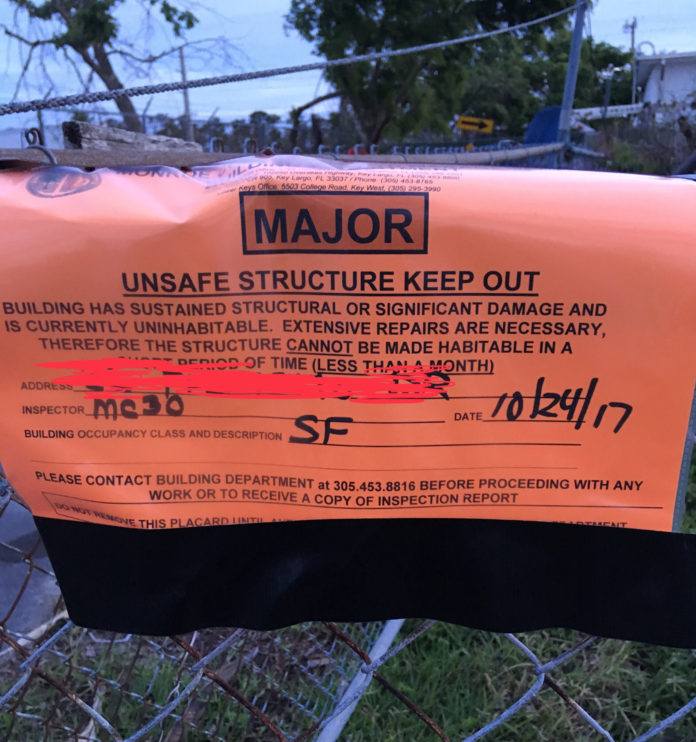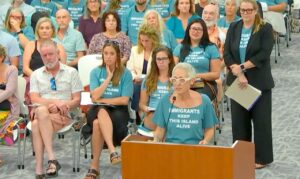
The letter arrived. They have been out of their Big Pine Key home since Sept. 10, 2017 when it took on two feet of storm surge in the ground-level house. The surge also caused substantial foundation damage to the home.
Fifty-two percent damage.
“We have been waiting for this for insurance so we can rebuild,” said the resident, who wished to remain anonymous at his lawyer’s request. He, his wife, and their two sons have been living at a friend’s house for four and a half months. With the letter, they hope to have enough ammunition to get insurance to pony up with the cost of compliance money they have been asking for.
The county sent out 931 “letters of substantial damage” to homeowners in unincorporated Monroe County. The determinations were done by the county through FEMA software.
“We have been inundated with folks who need assistance,” said Lori Lehr, of Monroe County’s Floodplain Program.
Three people are in the office answering the calls, including from residents waiting on the letter for insurance purposes, especially since some people have already demolished their homes. Some residents are also granting rights of entry so the property can be reassessed, and the office has been disseminating information regarding the permitting to determine if there is more than 50 percent damage. The permitting office is where homeowners can go for answers to their rebuilding or reassessing questions.
Although the family mentioned here sees the letter as a blessing, many are fighting the “substantial damage” designation on their homes.
A property owner who disagrees with the determination can challenge either the value of the property used to arrive at the 50 percent rule or the cost of repairs.
“We have not condemned any buildings yet,” said Monroe County Assistant Administrator Christine Hurley. “Bottom line, all of this can be worked out during permitting.”
If the structure is still more than 50 percent damaged, in order to meet current codes, owners have three choices: Elevate the structure, or change it in some other way to comply with those regulations to avoid future losses; relocate or demolish the structure; or flood-proof a non-residential structure.
The substantial damage assessment is different from the tagging system that took place after the storm. Just because a homeowner received an orange “major damage” tag or a red “destroyed” tag doesn’t mean that the house will necessarily fall under the 50 percent rule.
Jeanine Christiansen of Marathon came home to an orange “major damage” sticker on her door, saying that her house was uninhabitable due to the two feet of water her house took on. After months of ripping out drywall and removing all the furniture in the home, she was able to move back. “I immediately contacted the city to check what needed to be done, and the tag was just a reference that the house had been reviewed for damages and upon inspection I was able to move back in.”
Throughout Monroe County, including the incorporated areas, the tagging system included 2,977 homes with major damage orange tags, and 1,179 homes that were destroyed or “red tagged.”
In an upcoming article, The Weekly will go over grants homeowners can apply for to help with costs associated with coming up to code.
For questions regarding a homeowner’s substantial damage determination contact Lori Lehr at 305-407-6585 or email FloodInformation@MonroeCounty-fl.gov.
With an appraisal or tax roll, as long as the repairs are less than half of that, certified from a contractor, they can get the permits. It’s OK with FEMA and it’s OK with the City. Plus, FEMA is allowing the appraisal and tax bill to add 20 percent, I think all of the incorporated cities in Monroe County are following that, too. — Ed Borysiewitz, Key Colony Beach Building Official.
THE 50% RULE
“Substantial damage” applies to a damaged structure in a Special Flood Hazard Area — or floodplain — for which the total cost of repairs is 50 percent or more of the structure’s adjusted market value before the disaster occurred, regardless of the cause of damage.
“Market value” means the county property appraiser’s value of the structure plus 20 percent. If you disagree with the property appraiser’s value, you may submit a uniform appraisal report for determination of market value. Land value is excluded from the determination. For example, if a structure’s adjusted market value before the damage was $200,000 and repairs are estimated to cost $120,000, that structure is “substantially damaged.”
If your structure is substantially damaged, you will receive a letter.
If you disagree with a decision about substantial damage, you may submit a complete cost estimate for the repair of all damages sustained by your home that is prepared and signed by a licensed general contractor. Your contractor will be required to sign an affidavit indicating the cost estimate submitted includes all damages to your home, not just structural.
























